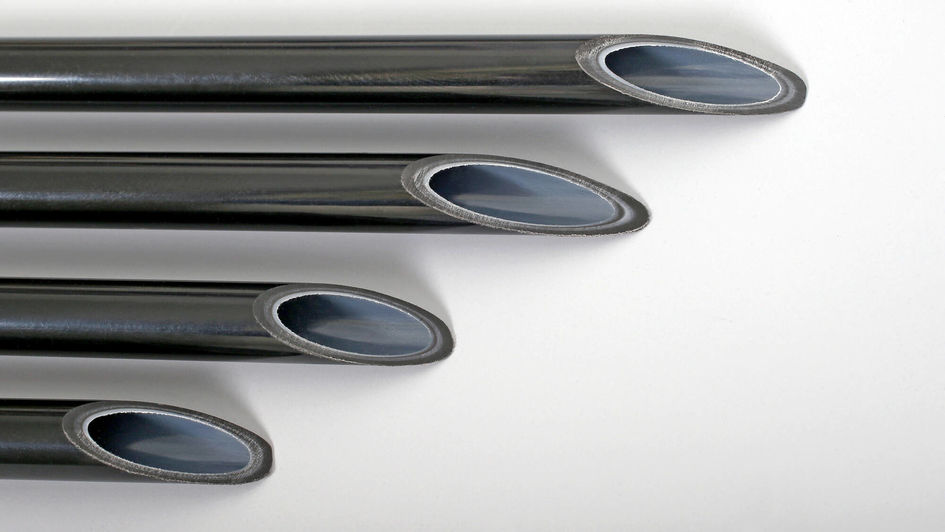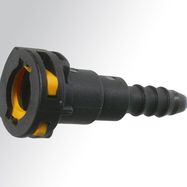The PIONIER For 50 Years
VESTAMID® IN Fuel-Line Systems
What will the fuel of the future look like? To be honest, nobody yet knows. But one thing seems quite certain: it will flow through lines. And as far as multilayer fuel lines go, with VESTAMID® we’ve been global market leaders for decades. Worldwide, it is the most widely used polyamide 12 in fuel lines. Consistently high product quality, dependable delivery, and excellent service, as well as innovative solutions in the development of our tubing compounds have helped us achieve this position and maintain it.
DIFFERENT COMPOUNDS FOR DIFFERENT REQUIREMENTS

We have responded to the different requirements in the specifications of the various automotive manufacturers by developing a range of finely graded extrusion compounds. They differ mainly in flexibility and bursting pressure, and in part also in low-temperature impact strength. Depending on the modification, the barrier effect against the permeation of hydrocarbons changes. The strain at break of the tubing, which is used by many automotive manufacturers as a quality criterion, depends essentially on the processing conditions and the calibration procedure. With proper extrusion, the required values can be achieved without any problems.
In principle, most VESTAMID® compounds intended for fuel lines are suitable for both gasoline and diesel fuels. In order to withstand the increasing engine compartment temperatures, especially in vehicles from European manufacturers, we have also developed high-temperature-resistant compounds. These are specially designed for use in either gasoline or diesel systems and should therefore only be used accordingly. Examples are VESTAMID® LX9008 and VESTAMID® LX9013.
In the late 1980s, Europe and the United States began developing fuel lines with multiple layers. The impetus for the new design came from the increasing stringency of the requirements by the U.S. agencies CARB and EPA for reducing hydrocarbon emissions from the use of motor vehicles. Compared to monowall tubing, multi-layer tubing displayed reduced fuel permeation by 1 to 2 orders of magnitude.
Evonik has not only responded to the increased requirements but developed pathbreaking new combinations of materials. Our compounds are optimized so that they can be extruded at speeds comparable to those of monowall tubing. Because certain multi-layer designs use no adhesion promoters and can be fabricated nearly without having to change the usual monowall tubing technology, the technical expenditure required to begin producing multi-layer tubing is minor. Our wide range of compounds for multi-layer tubing also allows us to develop special customized systems.
Recently, the demand for conductive fuel lines has become increasingly important. The use of conductive plastic tubing for supply and return lines has become mandatory for U.S. car manufacturers, but Japan and Korea, as well as individual manufacturers in Europe, are also following this trend. The technical requirements and conditions for this are described in detail in SAE J1645.
With the multilayer tubing systems (MLT) 4800 and 4840, Evonik responds to new requirements in the automotive industry – low extractable fuel line systems. Both systems with inner layers of low extractable VESTAMID® polyamide offer significantly reduced levels of extractable substances. MLT 4840 is also antistatic.

Quick-connect fittings ensure fast, cost-effective connection of fuel lines. Our product range includes reinforced and non-reinforced VESTAMID® compounds, which are also available in electrically conductive variations. Conductive connecting elements are increasingly required in the United States and Japan.
For more temperature-resistant fuel lines, we offer appropriate connector compounds based on polyamide 612. Molding compounds for welded connectors are also available; tightness is increased through a substance-to-substance bond of the fuel line and bonding agent. Retainers are also made from VESTAMID® D and are used in many quick connector designs.
In addition, various branches and valves for fuel systems are also made from VESTAMID®.
Resistance to fuel is the primary requirement of fuel filters. In addition to outstanding resistance, filter end caps made of VESTAMID® L1723 also offer excellent flexibility. With the appropriate design, end caps serve as sealing elements, eliminating the need for O rings. They also weld well to the filter material, which is typically made from VESTODUR® X7065, a polybutylene terephthalate molding compound from Evonik.

